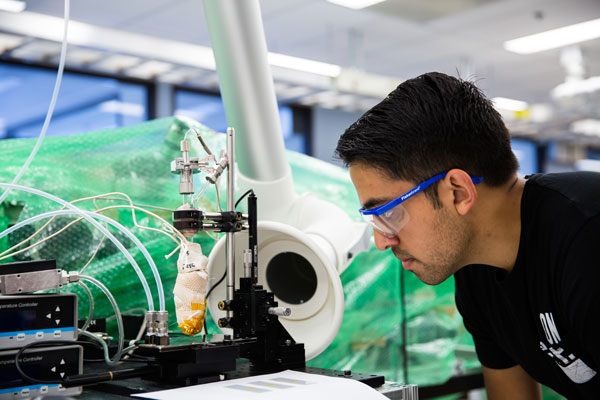
Siddharth Suresh Borsadia prints fluorescein crystals with gas-jet printing. (Levi Hutmacher, University of Michigan)
29 September 2017. A team of material scientists and biomedical engineers designed techniques for producing pharmaceuticals on demand by printing drugs as thin films. Researchers from University of Michigan in Ann Arbor describe their process in the 27 September issue of the journal Nature Communications.
The team led by Michigan materials scientist Max Shtein is seeking better methods for producing medications in safe doses, and with delivery methods best suited for the patients. Shtein and colleagues are also seeking techniques to make drugs that dissolve easier than conventional drugs, which could make available more medications now rejected for low solubility when given as pills or capsules.
The researchers adapted a technique from semiconductor fabrication called organic vapor jet printing for printing fine circuits on computer chips. In this case, the drug’s active ingredients are reduced to nanoscale crystals, combined with an inert gas, such as nitrogen, to carry the particles through a jet printer to the target surface. The surface receiving the jet is cooled so the gas dissipates, leaving behind a film of the condensed drug ingredients. The process allows for adjusting the size and shape of the deposited drug films, making possible a wide variety of dosage quantities, for printing on any number of delivery media.
The researchers tested the process with several organic compounds and current drugs, including the common fluorescing reagent fluorescein, caffeine, pain killer ibuprofen, pain and fever drug paracetamol, the cancer drug tamoxifen, and inflammation and cancer compound BAY 11-7082. These compounds were printed on a variety of media, such as glass lab slides, Tegaterm medical dressings, Listerine tabs, and stainless steel microneedles used in drug-delivery patches. In lab tests, the results show the printed drug films exhibited the same chemical activity as the compounds formulated as powders.
The Michigan team separately tested the printed cancer drugs tamoxifen and BAY 11-7082 against their original forms. In these tests, the researchers found the printed drugs destroyed cancer cells in lab cultures similarly to the medications mixed with the organic solvent dimethyl sulfoxide, a common ingredient in drugs to enable absorption in the body.
The gas-jet technique could also produce personalized drug combinations for patients, rather than prescribing multiple drugs. “A doctor or pharmacist can choose any number of medications, which the machine would combine into a single dose,” says Shtein in a university statement. “The machine could be sitting in the back of the pharmacy or even in a clinic.”
The first users of gas-jet printing, however, may be pharmaceutical companies themselves. The authors foresee drug makers using the methods to speed up drug testing, as well as incorporating the process into continuous manufacturing techniques. Members of the team plan to collaborate with experts in drug design and manufacturing to scale-up the process for continuous manufacturing.
More from Science & Enterprise:
- 3-D Printing Process Developed for Living Tissue
- Nanotech Treatment Studied for Brain Tumors
- Trial to Test Spherical Nanotech Brain Cancer Drug
- Sound Waves, Nanotech Delivery Boost Cancer Drug
- Nanoparticle Vaccine Stops Tumor Growth
* * *

 RSS - Posts
RSS - Posts
You must be logged in to post a comment.